Riding lawn mower engine spins but won't start video
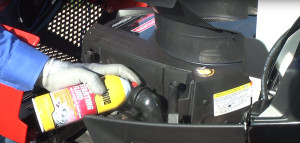

Find out what to do when your riding lawn mower spins but won’t start. Once it's spinning, the engine needs 3 things to run—fuel, spark and compression. This video helps you find out which one of those elements is missing in your engine by showing you a quick starter fluid test that can rule out several issues. Then we’ll show you how to check for problems with the fuel supply, the spark plug, ignition coil and flywheel key. Following these troubleshooting steps should help you get your riding lawn mower started so you can get back to mowing.
For additional repair help, including common symptoms and troubleshooting tips, step-by-step riding lawn mower and tractor repair guides and articles, check out our repair help section. In addition, find the riding mower parts you need to fix your mower.
Supplies you might need
Fresh gasoline (if old)
Ignition coil (if spark plug wire is damaged or there’s no spark)
Spark plug tester
Cylinder compression gauge (if all else fails)
The supplies you need depend on how far into the troubleshooting steps you go before solving the problem. Starter fluid is used in the first test, so you do need it.
Hi, Wayne here from Sears PartsDirect. Today we're going to troubleshoot a riding lawn mower engine that spins but won't start when the starter motor runs. Once it's spinning, the engine needs 3 things to run—fuel, spark and compression.
Test the fuel supply
Here's a quick test that can often eliminate 2 of those suspects right away. We'll check to see if the engine has compression and spark by spraying a short burst of starter fluid into the engine's cylinder. The highly combustible starter fluid will start the engine briefly if the cylinder gets spark and the right amount of compression.
In a well-ventilated area, pull off the air filter and spray a short burst of starter fluid into the cylinder through the carburetor's air intake. Now try to start the engine.
If the engine doesn’t start at all, you can skip the next section on fuel system troubleshooting and move on to checking the ignition system.
If the engine starts briefly and then dies, you know the spark and compression are okay, leaving you with a fuel supply problem.
Troubleshoot the fuel system
A dirty carburetor is usually the culprit when the engine isn't getting fuel. But, before you replace or rebuild the carburetor, check these basic fuel supply issues so you don't waste your money on a part that you don't need.
If the air filter you just pulled off is dirty, replace it. You need a clean air filter so the right amount of air can mix with the fuel to start the engine. Here's a video that shows how to replace the air filter.
If you haven't used the riding mower for several months, drain and refill the fuel tank with fresh gas. Over time, gas absorbs water and loses combustibility. In the future, if you don’t use up all the gas before storing your riding mower for several months, add fuel stabilizer to your gas tank.
Replace the fuel filter if you haven't changed it within the last year. A clogged fuel filter won't allow gas to flow to the carburetor. Here's a video that shows you how.
Check the wire harness connection on the fuel solenoid valve. The fuel solenoid valve shuts off fuel to the carburetor to prevent backfire when you kill the engine. If the wire's disconnected, the solenoid won't open to allow fuel to flow to the carburetor. Reconnect the valve wire harness if you find it disconnected.
Check the fuel line from the fuel tank to the carburetor for clogs or damage. Clear any clogs and replace the fuel line if damaged.
If your engine has a fuel pump, replace the pump if it doesn't move gas through the fuel line to the carburetor.
If you found no problems when checking these fuel system issues, then rebuild or replace the carburetor to restore the fuel supply to your engine. Here's a video that shows how to replace the carburetor and one that shows how to rebuild it.
Troubleshoot the ignition system
If your engine didn't start with the help of starter fluid, check the ignition system.
First, make sure you have the spark plug wire firmly connected to the plug. Replace the ignition coil if you find damage to the spark plug wire because the wire is part of the coil. Here's a video that shows how.
If you found no problems with the spark plug wire, pull the spark plug wire off the spark plug and remove the spark plug. Check the spark plug tip for carbon or oil deposits that could prevent the plug from sparking. Also, check for cracks in the plug’s insulator. Replace the spark plug if it’s too fouled to spark or the insulator is cracked. Here's a video that shows how.
If the spark plug looks okay, use a spark plug tester to see if the plug gets current from the ignition coil. To test it, install the spark plug and connect the boot of the tester to the spark plug. Connect the engine's spark plug wire to the other end of the tester. Crank the engine and see if the tester sparks.
If the tester doesn't spark, it’s likely you need to replace the ignition coil. Here's a video that shows how.
Check the flywheel key
If the plug sparks, that means the ignition coil is good, but the timing for the spark might be off.
Here's how the timing works on a riding lawn mower engine.
The flywheel magnet and ignition coil control spark timing. When the flywheel magnet passes the ignition coil, the coil generates and sends current to the spark plug, causing the spark.
The flywheel key keeps the flywheel aligned on the engine crankshaft so the magnet passes the ignition coil at the right time.
The flywheel key is a small metal rectangle that keeps the crankshaft and flywheel aligned when you tighten the flywheel bolt. To protect expensive engine components from damage, the flywheel key shears if a mower blade hits an object with enough force to make the flywheel slip out of alignment with the crankshaft. If you hit a rock or stump and the engine suddenly stops, you may have knocked off the timing by damaging or breaking the flywheel key.
A damaged flywheel key means the magnet won't pass the ignition coil at the right time for the spark plug to ignite the fuel to start and run the engine.
If this scenario sounds familiar because you did hit an object while mowing and the engine stopped, remove the flywheel and check that key. Replace the flywheel key if you find damage. Here's a video that shows you how.
Check the cylinder compression
If you find no problems with the ignition system, then a compression problem could be preventing the engine from starting.
Check the oil level to see if the engine is overfilled. Drain some oil to drop it below the maximum fill level.
If the oil level is okay, pull out the spark plug and check cylinder compression using a compression gauge. This test shows whether the piston is compressing the air and fuel mixture in the cylinder.
Connect the compression gauge to the cylinder through the spark plug hole. Zero the compression gauge. Briefly turn the key to the start position so the starter motor spins the engine.
Check the compression reading. Most engines should measure over 40 psi of compression. Many engines produce more than 80 psi.
If cylinder compression is less than 40 psi, the piston isn't compressing air inside the cylinder. Keep in mind that a low compression reading shows you that a compression problem exists, but doesn't reveal the cause. You might need to adjust the valves or replace the piston rings. A damaged cylinder wall can also prevent the piston from compressing air inside the cylinder.
To accurately analyze a compression problem, have a service technician do a leak-down test on the engine. The technician will use an air compressor and special tools to find where the air leaks.
Once the technician finds the cause of the compression problem and fixes it, you can get back to mowing.
I hope this video helps you out today. Check out our other videos on the Sears PartsDirect YouTube channel and subscribe to see when we post new videos.
Most common symptoms to help you fix your riding mowers & tractors
Choose a symptom to see related riding mower and lawn tractor repairs.
Main causes: faulty battery, bad alternator…
Main causes: damaged cutting blade, worn deck pulley, damaged mandrel pulley, loose fasteners on mower deck components…
Main causes: damaged tie rods, bent or worn wheel spindle, worn front axle, damaged sector gear assembly…
Main causes: worn or broken blade belt, broken belt idler pulley, blade clutch cable failure, bad PTO switch, damaged ma…
Main causes: punctured tire or inner tube, leaky valve stem, damaged wheel rim…
Main causes: engine overfilled with oil, leaky head gasket or sump gasket, damaged carburetor seals, cracked fuel pump, …
Main causes: clogged carburetor, damaged flywheel key, dirty spark plug, stale fuel, improper valve lash, engine needs a…
Main causes: shift lever needs adjustment, neutral control needs adjustment…
Main causes: worn or broken ground drive belt, bad seat switch, transaxle freewheel control engaged, transaxle failure, …
Most common repair guides to help fix your riding mowers & tractors
These step-by-step repair guides will help you safely fix what’s broken on your riding mower or lawn tractor.
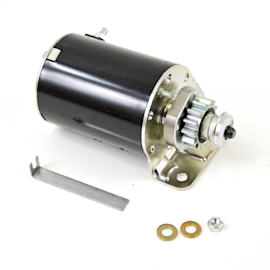
How to replace the starter motor on a riding lawn mower
If you hear the solenoid click but don’t hear the starter motor spin when you turn the key, follow these steps to replac…
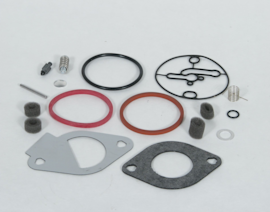
How to rebuild a riding lawn mower carburetor
Get your sputtering carburetor running smoothly in 60 minutes.…
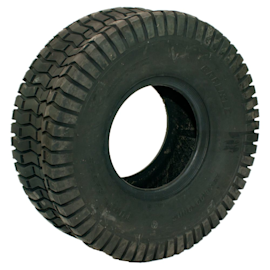
How to replace a riding lawn mower rear tire
Your mower can’t run on a damaged rear tire. Here’s how to install a new one.…
Effective articles & videos to help repair your riding mowers & tractors
Use the advice and tips in these articles and videos to get the most out of your riding mower or lawn tractor.

Learn about all the convenient features on our Sears PartsDirect website that make your parts purchases easier.…

Get answers to frequently asked questions about Sears and Sears PartsDirect.…
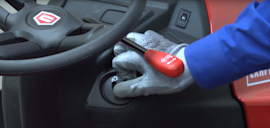
Check the starter solenoid, starter motor, wiring, battery and engine.…